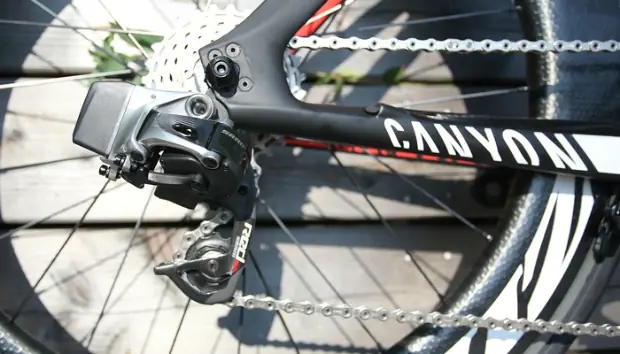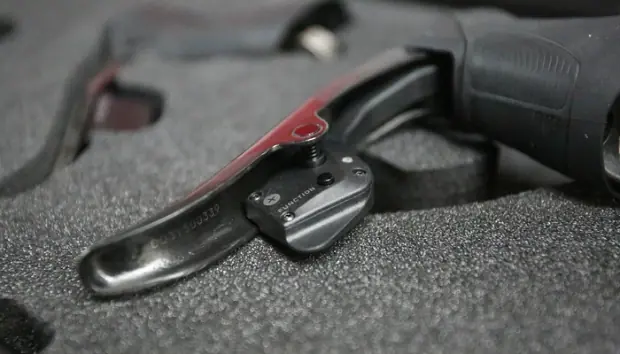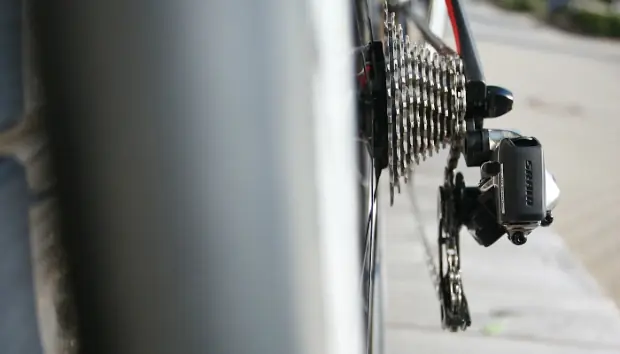
Mechanical Advantage is dead. Long live Mechanical Advantage.
When Shimano debuted the industry's first electronic groupset, SRAM stood fast to a pitch that the industry would be mechanically cabled, and sold the world on it; The Mechanical Advantage.
Behind the scenes, however (since 2011, in fact), the company was hard at work.
Just a few years later, SRAM finally comes forward after several pieces were seen in the field under the bikes of Jan Frodeno, Sebastian Kienle and Mirinda Carfrae, and several UCI WorldTour teams this year. (Frodeno, in fact, was the first triathlete to earn a win on the then secrecy-shrouded groupset, winning Ironman 70.3 Oceanside this spring.)
More: IRONMAN Sold For $650 Million To Chinese Company
For SRAM, the future will be electrified. Wirelessly. Today SRAM debuts RED eTap, the company's--and the industry's only current wire-free electronic groupset.
LAVA was invited to SRAM's massive development headquarters in Schweinfurt, Germany (in the heart of Bavaria smack dab between Frankfurt and Roth), to explore the new groupset and test it on the rolling roads around Schweinfurt. Our initial assessment? To be succinct, it's a game changer, for road and certainly for triathlon. And to be clear, it's not ready for prime time just yet; it won't spec on any of the 2016 bikes on show at Eurobike today... think Spring 2016 availability, and 2017 spec on bikes.
WHY ELECTRIC WIRELESS?
Well, the "electric" part is obvious: it works. Back in 1999, Mavic debut the first true wireless groupset with Mektronic, using coded radio waves to move the derailleurs, while relaying gear position. But it was wrought with engineering issues and scuttled.
In the interim, cabled electronic came to market in 2009.... and settled in to a successful place in road and tri bikes, with Shimano's Di2 Dura-Ace being supported eventually by the equally functional but less expensive Di2 Ultegra. SRAM sat for too long and let Shimano and Campagnolo own in the electronic sandbox. So in coming to the space, they had to do something that wasn't a copy, but an improvement on the current electric standard. And that meant going wireless. Cut out connections that can fail. Cut out difficult routings and tough setup. Cut out (potentially) weight.
That, and the industry was changing to accommodate electric. Almost exclusively.
"Consider this: Canyon doesn't even make a mechanical-capable triathlon bike anymore," said SRAM Pro Liaison Alex Wassman. "With the market changing like that, it was important for us to be a leading, proactive part of that change."

SHIFTING
Anyone that is familiar with paddle shifters on Formula One race cars (or on their Porsche at home) can guess to the inspiration for eTap; single-button simplicity and efficiency. SRAM does it, and does so wirelessly, using it's own homemade, low-power signal algorithm. And powers it on the good 'ol easily-available CR2032 watch battery.
Rightly so, SRAM pumps up the intuitive nature of the shifting, and it's the right word; there's no thinking involved. It goes like this: right shifter goes down the cassette. Left shifter goes up the cassette. Tap both shifters at the same time, and the front derailleur switches either from little to big or big to little. That's it. "We believe if a technological advance clutters the experience, then it shouldn't be called an advance at all," says SRAM Road Brand Director Chris Zigmont.
ROAD BRAKE SHIFTERS
The road brake shifter has many of the same design features it has before, including reach adjust, and because the hood didn't have any mechanical pieces within eating up real estate, SRAM design engineers pared it down slightly... but it still has the same general shape and feel as the most current mechanical iteration.
More: Ask A Coach: Should I Weight Train?
The Ergoblade shift levers don't require "throw" to pull cable, instead actuating a shift with a discernable "click" that, with a visible spring, is its own tactical action, a feel not like Shimano or Campagnolo. It's a pleasant shift, with a resistant dome spring that gives under pressure such that an accidental shift isn't possible, but a definitive shift, even on an icy day with thick gloves on, will be definitive.
Gear range sweep will move across when hold shifter down. That action is slower than competitors, and it's by design. "That came from my group interacting with pro athletes," Wassmann said. The reason was functional; the speed allowed the chain to move across the cassette teeth, instead of "chattering" across a few teeth. The result is a more succinct, efficient and definitive shift action. Under load, it's a confident feature.
SRAM says the batteries in the shifters should last around two years before needing to be changed.

REAR DERAILLEUR
SRAM said this is the meat of the system, taking the most action from the shifters. Again, it has the requisites: ceramic pulley bearings, 1:1 Exact Actuation shift throw, With a carbon fiber lower jockey and a grey and black alloy body, weight is 239 grams with battery, 215g without.
Install and setup and adjust is easy; install derailleurs, install road brake shifters (or in the case of a tri bike, Blip Buttons, which we'll talk about), and pair. The process of pairing took about 15 seconds.
More: 3 Leg-Strengthening Bike Intervals for Triathletes
From there, derailleur adjustment was simple as well; clip the lightweight lithium polymer battery into the rear-loaded housing, lock it down with a firm latch, adjust the limit screws, then hold the setting button at the front of the derailleur's body, which will cause a light to fire up green, allowing for micro-adjust in either direction within 2/10ths of a millimeter, providing for 26 positions within a gear; 13 to either side. With the setting done via either the road shifter's inboard button or the Blip Box for tri bikes, there's no chance of accidentally going into an adjustment mode.
And (hallelujah, mechanics rejoice here): there's no cables, no housing, no stops. No battery to mount. No tape. And no zip ties.
SRAM also created a brilliant crash feature for the rear derailleur; in the event of a driveside crash, the rear derailleur simply resets to the shift it was previously in. And if it's pulled outboard (for example, if the front wheel of a rider wedges between the rear wheel and rear derailleur), the clutch moves it back into place. We hauled on a demonstration rear derailleur to see how it works, and it's remarkable; squeeze or pull apart the rear derailleur's parallelogram, and with an audible buzz, the clutch moves it back to its start position. "At this point, we're more worried about damage to a derailleur hanger than the derailleur now," McLaughlin says.
SRAM says that on average, the rear derailleur battery will run at least 1000 kilometers (about six weeks of riding or 60 hours of heavy shifting) before needing a charge, which takes just 45 minutes to get to full capacity. Batteries will have about 100 charge/discharge cycles in its life, with SRAM saying the battery will degrade from time and temperature variances more quickly than from use.


